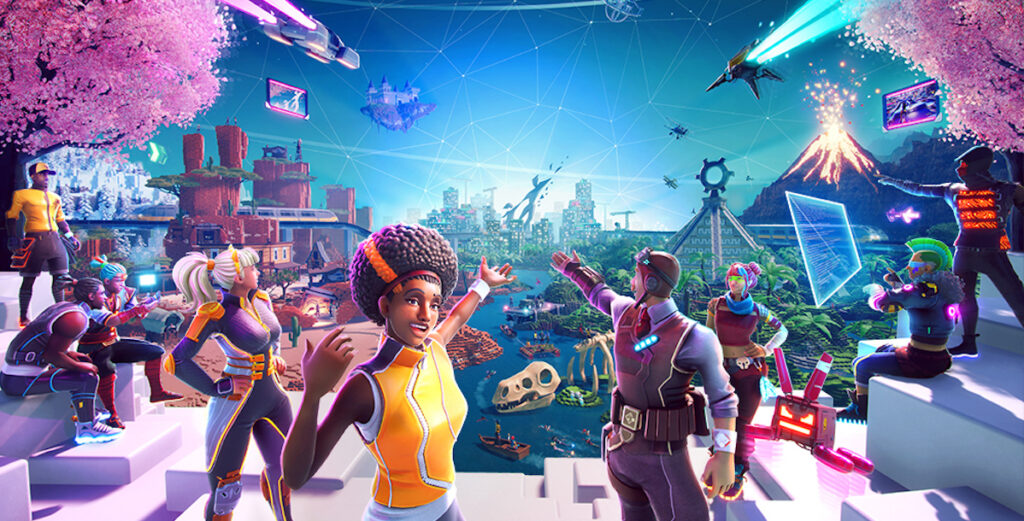The Metaverse’s immersive and interactive nature opens the door for a new type of social interaction, creating complex, dynamic virtual communities that mimic, complement, and even transcend physical world relationships.

Join us as we delve into the social fabric of Metaverse gaming- Building virtual communities.
The Metaverse, a mind-bending combination of virtual and real worlds, is poised to change how we interact online.
Imagine attending a concert with friends from all over the world, feeling the intensity of the audience and the virtual wind whipping through your hair, all from the comfort of your living room.
This isn’t science fiction anymore; the Metaverse has arrived and significantly altered the social media environment.
The face of social media is changing dramatically. The days of flat screens and filtered selfies are giving way to a more immersive and participatory experience: the Metaverse.
This groundbreaking concept, based on the merging of virtual reality (VR) and blockchain technology, is poised to reshape the future of social interaction.
But how does the Metaverse affect social media, and what are the ramifications for users and online communities?
While effective at fostering connections, traditional social media sites frequently lack a sense of “real” presence. Scrolling through a newsfeed can feel passive and distant.
The Metaverse, on the other hand, immerses users in 3D virtual environments in which they can communicate with one another via avatars, simulating the intricacies of physical conversation.
Facial expressions, gestures, and spatial proximity in these virtual settings create an additional connection layer, encouraging greater engagement and a stronger sense of “being there.”
Imagine attending a virtual concert with friends worldwide, feeling the crowd’s energy, and communicating with them in real-time via your avatars—a far cry from simply viewing a live feed.
GenZs and younger generations who have grown up in a digital age need interactive and immersive experiences.
These digital natives are particularly drawn to the Metaverse, which combines gaming, social engagement, and virtual economy.
From virtual fashion shows to virtual museums, the Metaverse provides an unrivaled environment for inquiry and expression.
This intrinsic attractiveness leads to higher user engagement, allowing marketers and content creators to connect with younger audiences on a whole new level.
Virtual communities are the foundation of the Metaverse’s social structure. With the option to create bespoke avatars and virtual places, users can connect with others who share similar interests.
Consider a virtual book club where members meet in a 3D reproduction of a pleasant library or a fitness group that trains together in a virtual gym; the options are limitless.
These virtual communities generate a sense of belonging and shared purpose, bridging geographical divides and providing a more meaningful social experience.
Social Interactions in Virtual Communities
Immersive and interconnected areas foster social engagement among virtual communities in the Metaverse, which provides people with unique possibilities to participate and connect.
These virtual communities combine advanced technology and virtual reality to create an environment where people may engage with one another beyond physical distances.
Virtual events are a common type of social engagement in the Metaverse. These events, such as concerts, conferences, or workshops, let participants interact with one another in real time.
Collaborative projects also promote social interaction since people worldwide can come together to work on common goals while using their unique skills and knowledge.
Networking opportunities are another critical component of social engagement in virtual communities.
Individuals can connect with others who share their interests and professional backgrounds in these settings, resulting in beneficial connections and partnerships.
These virtual communities offer a platform for networking without the constraints of physical boundaries.
Inclusivity, moderation, and community norms are essential for creating a positive and constructive environment in virtual communities. Making all members feel accepted and appreciated, regardless of background or qualities, is critical.
Moderation reduces harassment, bullying, and other negative behavior, resulting in a safe environment for social interaction.
Community guidelines establish a framework for appropriate behavior and expectations for participation in these virtual communities, promoting a healthy and supportive environment.
Ultimately, immersive and interconnected areas encourage social engagement among virtual communities in the Metaverse, allowing for virtual gatherings, collaborative projects, and networking.
Inclusivity, moderation, and community norms are critical for creating a healthy climate in these places, allowing all people to engage and connect respectfully and constructively.
Importance of Building Virtual Communities
Building virtual communities in the Metaverse provides several benefits to both individuals and society as a whole. It allows people to connect and develop relationships with others from many walks of life and cultures.
This exposure to many opinions and ideas improves understanding, empathy, and a feeling of global citizenship.
Second, virtual communities act as knowledge-sharing and collaboration hubs. Users can join to learn new skills, share expertise, and collaborate on projects beyond physical limits. This collective intelligence promotes creativity and the creation of new technology and ideas.
Lastly, virtual communities allow people to discover support, encouragement, and inspiration. In a society that can sometimes feel detached and isolated, these communities serve as a support system, providing a sense of belonging and purpose.
Building Virtual Communities: The Social Fabric of Metaverse Gaming

Building virtual communities is an essential component of Metaverse gaming. Instead of offering solitary game experiences, the Metaverse promotes collaboration, competitiveness, and social connection.
Players can team up to fulfill objectives, compete in tournaments, or simply interact in a virtual environment.
Platforms such as Roblox, Fortnite, and Zepeto have evolved into social metaverses where people meet to play and socialize, attend concerts, and even participate in virtual fashion displays. This shift toward social gaming changes our thoughts about online communities and social networks.
Challenges and Possible Solutions in Building Virtual Communities
Building communities in the Metaverse has several potential but presents distinct obstacles. Some of these include;
- Lack of physical presence
- Toxicity and possible harassment
Lack of Physical Presence
One of the primary issues is a lack of physical presence and face-to-face engagement. This can make it challenging to gain trust and form lasting connections.
However, this problem can be overcome by developing a solid online presence, supporting regular connections, and organizing virtual meetups and gatherings.
Toxicity and Possible Harassment
Another challenge is the possibility of toxic conduct and harassment inside virtual communities.
To solve this, community leaders must develop and implement clear norms consistently. Moderation tools and reporting procedures can also provide all participants with a safe and inviting atmosphere.
A Sense of Belonging in Metaverse Virtual Communities
Developing a sense of belonging in virtual communities is vital for encouraging connection and participation across these diverse and dynamic digital platforms.
Individuals can have a strong feeling of belonging and form meaningful connections with others by taking advantage of the distinct characteristics of virtual communities.
One way to foster a sense of belonging is to promote and actively embrace diversity in virtual communities.
By celebrating community members’ diverse backgrounds, experiences, and viewpoints, these platforms may build an inclusive environment where everyone feels respected and accepted.
This can be accomplished by organizing events, talks, and projects to encourage cultural interaction, empathy, and understanding among members.
Virtual communities offer several chances for growth, learning, and support. These platforms provide a wealth of knowledge and information since users can quickly share resources, experiences, and skills on various subjects.
Whether through educational programs, mentorship opportunities, or discussions, virtual communities allow people to broaden their abilities, obtain new perspectives, and receive support from others.
Virtual communities can take many forms, including interest-based clubs, virtual neighborhoods, and complete virtual worlds.
These communities might focus on specific topics, hobbies, industries, or social concerns, allowing people to interact with others who share their interests or aspirations.
Also, virtual communities can be built around specific physical places, allowing people to connect with others in their immediate surroundings and develop a sense of neighborhood belonging.
Final Thoughts
Virtual communities provide an abundant platform for individuals to cultivate a sense of belonging by embracing variety, giving opportunities for growth and learning, and connecting people with shared interests and objectives.
By leveraging these elements, virtual communities can serve as a haven for people seeking connection, support, and a sense of belonging.
